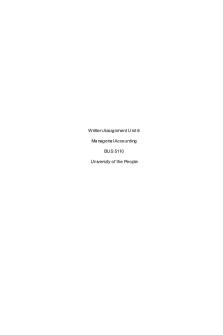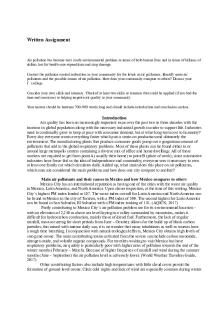WA-6, Report on Amazon - Written Assignment Unit 6 PDF

| Title | WA-6, Report on Amazon - Written Assignment Unit 6 |
|---|---|
| Author | Harleen Kaur |
| Course | Management Information Systems and Technology |
| Institution | University of the People |
| Pages | 7 |
| File Size | 129.1 KB |
| File Type | |
| Total Downloads | 66 |
| Total Views | 142 |
Summary
Written Assignment Unit 6...
Description
1
Case Report on Amazon
Anonymous Business School, University of the People BUS 5114: Management Information Systems Dr. Charlotte Barrett May 19, 2021
2 Case Report on Amazon Amazon, one of the largest e-commerce stores, was founded by Jeff Bezos in 1995. Amazon started its business by selling books online (Fleerackers, 2010). Amazon saw the success of selling books online and eventually moved on to selling music, electronics, toys, etc., almost everything a person could think of (Fleerackers, 2010). Amazon focused on delivering value to the customers instead of focusing on the technology, and that's how they were able to gain massive customer loyalty (Fleerackers, 2010). Description of the Case and Identification of Major Issues Having reached the top was not an easy thing for the firm. Amazon foresaw the digital world way before its competitors, and that's how they were able to reach the top. The following paper will discuss the factors that contributed to Amazon’s success which includes the competitive forces, value chain models and five P’s, as well as the limitations of its business model. The paper will also discuss the role of technology in the business and will provide possible strategies to overcome the limitations. Contributing Factors to Success Competitive Forces Michael Porter's five competitive forces are traditional competitors, new market entrants, substitute products and services, customers, and suppliers (Laudon & Laudon, 2007). Amazon is still competing with the traditional brick-and-mortar brands such as Walmart, "which has a significant and expanding e-commerce website" (Greenspan, 2019a). New companies are trying to imitate Amazon, but it's hard for the new firms to copy and leverage the resources the way Amazon does (Dudovskiy, 2020a). Amazon substituted the method of selling books in their early time, something its competitors failed to see.
3 When people bought physical CDs, Amazon made it possible for its customers to download the music online. Amazon is customer-centric, meaning they tend to provide the products at a price lower than its competitors to maintain its customer base. Amazon does not just think about its customers, but it also considerate its suppliers. Today suppliers from different parts of the world want to publish their products on Amazon than on any other medium. Value Chain Model The value chain model identifies the point where information technology (IT) can be best used (Laudon & Laudon, 2007). The value chain model can be categorized into primary activities and support activities (Laudon & Laudon, 2007). Amazon is well versed in its inbound logistics, operations, outbound logistics, marketing and sales, and service (primary activities). Amazon also excelled in its support activities like HR, finance, legal, technology, and procurement (Kandemirli, 2018). Five P’s The five Ps are product, place, promotion, price, and people. We all are well aware that Amazon sells hundreds of thousands of products through its website. The items sold are by Amazon's original products such as Alexa and Kindle, and also through third-party sellers. Approximately 58% of the items sold by Amazon are by their third-party sellers (Dudovskiy, 2020b). Though Amazon doesn't have physical stores, yet it's present all over the world. Although, Amazon is testing its new Amazon Go stores that sell groceries. Amazon Go is a cashier-less store that runs on artificial intelligence (AI). Amazon aims to keep its prices low than its competitors. As per Amazon policies, the sellers are supposed to market their product prices lower than their competitors (Sussman, 2019). Amazon also uses different pricing
4 strategies like market-oriented pricing strategy, price-discrimination strategy, and value-based pricing strategy (Ferguson, 2017). Yoshiyuki Nakagawa also mentions in the case study comment section that "Amazon prices in retails are indeed surprisingly low. One can't pass up Amazon when you think to purchase something." Amazon is a global brand, and to maintain its popularity, Amazon regularly advertises through campaigns on television, newspapers, social media, and billboards (David, 2020). Lastly, Amazon has excellent customer service, and the customer representatives are well versed in dealing with new and existing customers. Limitations 1. The major limitation to Amazon's business model is that the company is inundated with suppliers. As a consumer, if I have to buy one product, there are more suppliers than needed. Due to this, it's almost impossible for Amazon to verify claims, product quality, or even product authenticity (Whitler & Young, 2020). There have been many cases regarding fake products the consumers get. 2. Imitating an online retail store is not a big task (Greenspan, 2019b). Many companies have already done that and give competition to Amazon. For instance, in India, Amazon's competitor is Flipkart. Flipkart, influenced by Amazon, has a market share of 38.3% whereas, Amazon has a market share of 31.2% (Arcieri, 2019). 3. Another limitation is that Amazon doesn't sell its products at wholesale. Countries like China that is the hub of manufacturing, use Alibaba more than Amazon. Alibaba sells its products at wholesale making it more demanding and successful. 4. Each country has a different set of government regulations that hinder company sales. For instance, in the pandemic, the government of India banned sales of non-essential items on
5 Amazon to support the local market sales. This resulted in a loss of $398 million (Sudhakaran, 2020).
Strategies 1. Amazon should find ways to make its products more authentic for its customers. There should be strict policies for the suppliers who want to sell their products. It shouldn't be an open-door policy to maintain the genuineness of the products. 2. China is the largest market, and Amazon failed to capture it. Amazon should start selling products in wholesale to compete with Alibaba and capture the market. Conclusion "Companies like Amazon, Google, Netflix all have future-driven leaders who have a clear, consistent vision and have set the trend for a completely new business model" (Ricardo Dos Ramos - case study comment section). Amazon is already a pioneer, and still, Amazon tries to innovate new methods or products to remain successful.
6
References Arcieri, K. (2019, October 10). Flipkart is No. 1 in India but faces formidable foe in Amazon, say experts. S&P Global. https://www.spglobal.com/marketintelligence/en/newsinsights/latest-news-headlines/flipkart-is-no-1-in-india-but-faces-formidable-foe-inamazon-say-experts-54083920 David, J. (2020, September 12). Marketing mix of Amazon (4Ps of Amazon). Howandwhat. https://howandwhat.net/marketing-mix-amazon-amazon-marketing-mix/ Dudovskiy, J. (2020a, April 1). Amazon Porter's Five Forces analysis. ResearchMethodology. https://research-methodology.net/amazon-porters-five-forces-analysis-2/ Dudovskiy, J. (2020b, March 21). Amazon marketing mix (Amazon 7Ps of marketing). ResearchMethodology. https://research-methodology.net/amazon-marketing-mix-amazon-7psmarketing-2/ Ferguson, E. (2017, February 20). Amazon.com Inc.’s marketing mix (4Ps) analysis. Panmore Institute. https://panmore.com/amazon-com-inc-marketing-mix-4ps-analysis Fleerackers, T. (2010). Case: Amazon.com. Retrieved May 23, 2016, from https://flatworldbusiness.wordpress.com/flat-education/intensify/creating-a-flatbusiness/case-amazon-com/ Greenspan, R. (2019a, February 24). Amazon.com Inc. Five forces analysis & recommendations (Porter’s model). Panmore Institute. https://panmore.com/amazon-com-inc-five-forcesanalysis-recommendations-porters-model
7 Greenspan, R. (2019b, June 22). Amazon.com Inc. SWOT analysis & recommendations. Panmore Institute. https://panmore.com/amazon-com-inc-swot-analysis-recommendations
Kandemirli, B. (2018, July 2). (PDF) Amazon.com's digital strategies amazon.com case study. ResearchGate. https://www.researchgate.net/publication/326132044_AMAZONCOM %27S_DIGITAL_STRATEGIES_AMAZONCOM_CASE_STUDY Laudon, K. C., & Laudon, J. P. (2007). Information Systems, Organizations, and Strategy. Management Information Systems: Managing the Digital Firm 10th ed. Upper Saddle River, NJ: Prentice-Hall. Sussman, S. (2019, August 23). How Amazon's pricing policies squeeze sellers and result in higher prices for consumers. Pro Market. https://promarket.org/2019/08/23/howamazons-pricing-policies-squeeze-sellers-and-result-in-higher-prices-for-consumers/ Sudhakaran, A. (2020, September 28). Amazon SWOT analysis: 2020 a year to remember. PESTLE Analysis. https://pestleanalysis.com/amazon-swot-analysis/ Whitler, K. A., & Young, S. (2020, August 8). Amazon’s Business Model Weakness and How Walmart (And Other Retailers) Can Exploit It. Forbes. https://www.forbes.com/sites/kimberlywhitler/2020/08/08/amazons-businessmodel-weaknesses-and-how-walmart-and-other-retailers-can-exploit-them/? sh=80688991f4e7...
Similar Free PDFs

Written Assignment Unit 6
- 8 Pages

Written Assignment Unit 6
- 4 Pages

Unit 6 - Written Assignment
- 4 Pages

Written Assignment Unit 6 wa
- 4 Pages

WA6 - WA6
- 1 Pages

Assignment on amazon empire
- 8 Pages

Written Assignment Unit 2
- 3 Pages

Written Assignment Unit 7
- 3 Pages

Written Assignment UNIT 5
- 6 Pages
Popular Institutions
- Tinajero National High School - Annex
- Politeknik Caltex Riau
- Yokohama City University
- SGT University
- University of Al-Qadisiyah
- Divine Word College of Vigan
- Techniek College Rotterdam
- Universidade de Santiago
- Universiti Teknologi MARA Cawangan Johor Kampus Pasir Gudang
- Poltekkes Kemenkes Yogyakarta
- Baguio City National High School
- Colegio san marcos
- preparatoria uno
- Centro de Bachillerato Tecnológico Industrial y de Servicios No. 107
- Dalian Maritime University
- Quang Trung Secondary School
- Colegio Tecnológico en Informática
- Corporación Regional de Educación Superior
- Grupo CEDVA
- Dar Al Uloom University
- Centro de Estudios Preuniversitarios de la Universidad Nacional de Ingeniería
- 上智大学
- Aakash International School, Nuna Majara
- San Felipe Neri Catholic School
- Kang Chiao International School - New Taipei City
- Misamis Occidental National High School
- Institución Educativa Escuela Normal Juan Ladrilleros
- Kolehiyo ng Pantukan
- Batanes State College
- Instituto Continental
- Sekolah Menengah Kejuruan Kesehatan Kaltara (Tarakan)
- Colegio de La Inmaculada Concepcion - Cebu






